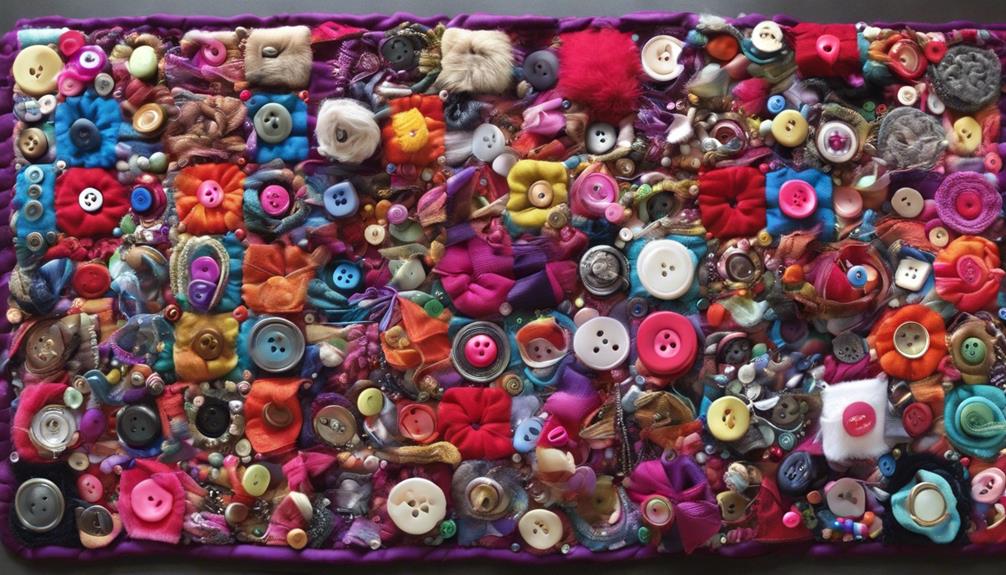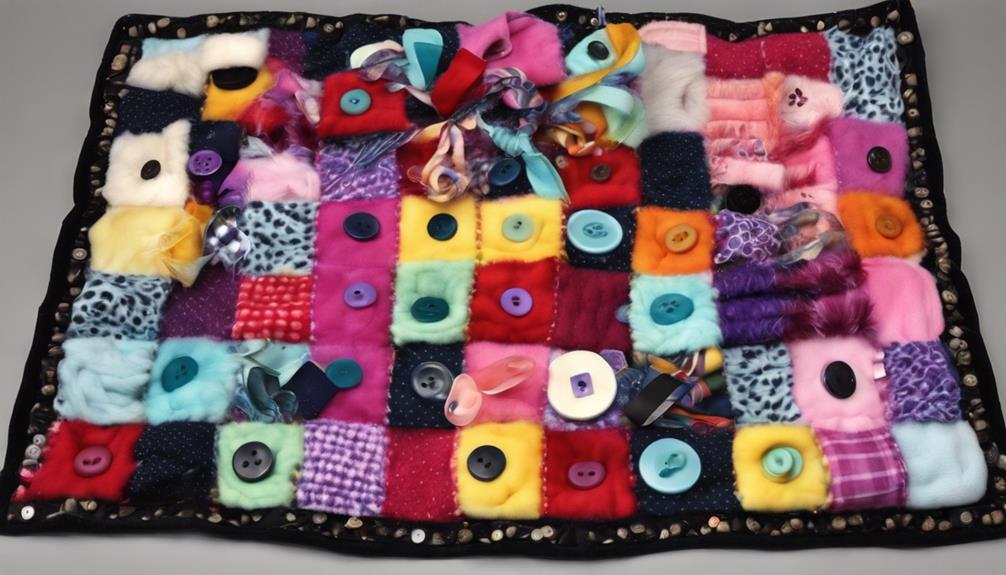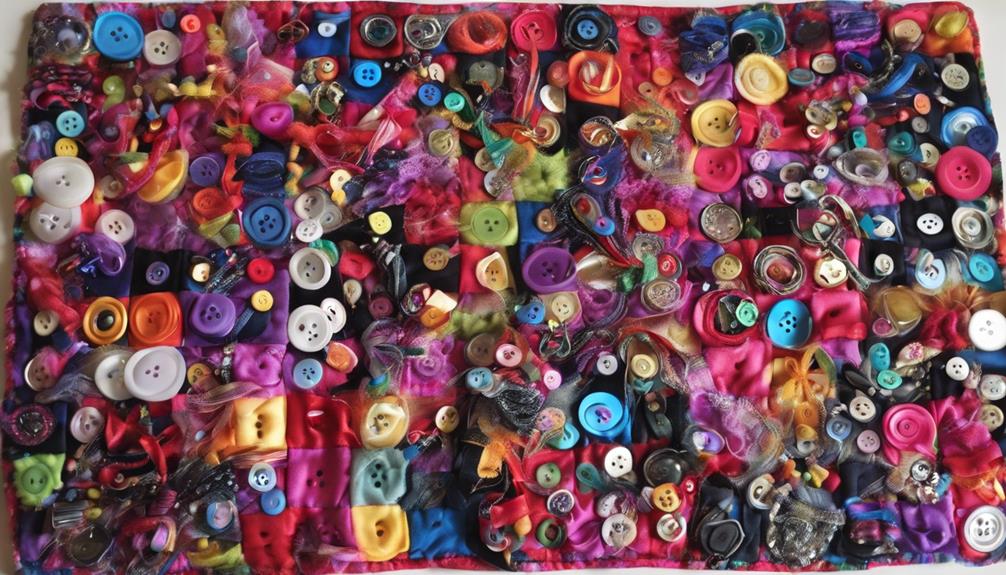In the world of dementia caregiving, fidget blankets serve as a calming solution for agitated minds, combining tranquility and engagement. These sensory marvels have transformed the approach to dementia caregiving, bringing a feeling of tranquility and meaning to those impacted by the condition.
But what exactly makes these blankets so special, and how can they truly make a difference in the lives of those battling dementia? Let's explore this innovative approach to care that is changing the landscape of dementia support.
Benefits of Fidget Blankets
Fidget blankets for dementia offer essential sensory stimulation and engagement for individuals facing cognitive challenges. These specially designed blankets, often weighted and filled with various textures and attachments, serve as powerful tools for enhancing sensory activities. By incorporating different fabrics and objects, fidget blankets provide a range of tactile experiences that can help individuals with dementia improve their focus, attention, and fine motor skills.
The weighted nature of these blankets can have a calming and soothing effect on dementia patients, reducing stress and anxiety levels. The sensory stimulation provided by fidget blankets not only enhances coordination but also acts as a source of sensory enrichment for those with cognitive issues. Moreover, these blankets offer emotional support, a sense of security, and a form of distraction for individuals with dementia, ultimately contributing to their overall well-being.
Through the simple yet effective means of sensory engagement, fidget blankets play a crucial role in improving the quality of life for those living with dementia.
How Fidget Blankets Help

In providing essential sensory stimulation and engagement, fidget blankets for dementia offer significant support for individuals facing cognitive challenges. These specially designed sensory blankets, often weighted, serve as a source of comfort and distraction for dementia patients. The calming effect of a fidget blanket can help reduce stress and anxiety, promoting a sense of security and emotional well-being. By incorporating various textures, fabrics, and attachments, these blankets stimulate the senses, aiding in improving focus, attention, fine motor skills, and coordination in individuals with dementia.
The tactile features of fidget blankets are intentionally crafted to enhance sensory experiences and provide a soothing touch for those struggling with cognitive impairments. This sensory engagement not only serves as a form of therapy but also offers a form of emotional support and distraction. The overall purpose of a fidget blanket is to create a safe and calming environment that encourages relaxation and promotes a sense of peace for dementia patients.
Choosing the Right Blanket
When selecting a fidget blanket for someone with dementia, it's essential to consider factors such as weight, material quality, and sensory elements to ensure optimal comfort and therapeutic benefits.
The weight of the blanket should ideally be around 10% of the individual's body weight, providing a comforting sensation without feeling too burdensome. Opt for fidget blankets crafted from high-quality materials like 100% cotton to ensure durability and softness against the skin, promoting a soothing experience.
Look for blankets with different textures, fabrics, and attachments to engage sensory processing effectively, stimulating the senses and aiding in relaxation. These sensory elements can help calm individuals with dementia, reducing stress and anxiety levels.
Additionally, selecting a fidget blanket designed to improve focus, attention, fine motor skills, and coordination can be beneficial for individuals experiencing memory loss, enhancing their overall well-being and quality of life.
Making Your Own Blanket

Creating a personalized fidget blanket can be a rewarding and meaningful project, offering a unique way to provide comfort and sensory stimulation for individuals with dementia. To make your own fidget blanket, gather volunteers, sewing machines, fabric, stabilizer, and decorations like wool, buttons, and zippers. Begin by layering the fabric with stabilizer, sewing around with one side open, then turning it inside out. Iron for fusion, and finally, stitch for completion.
When decorating, securely attach items like zippers, buttons, and soft toys to ensure both safety and sensory interest. Personalization options are vast, allowing for customization for specific clients, turning them into aprons, or adding unique touches under supervision. Community engagement is key; share comments, answer inquiries, offer advice, encourage collaboration, and provide resources for inspiration.
Making fidget blankets not only helps enhance motor skills but also fosters community engagement and a sense of purpose in serving those in need.
Safety Considerations
Moving forward from crafting your own fidget blanket, ensuring safety considerations are meticulously addressed is paramount to the well-being and enjoyment of individuals with dementia.
When it comes to the safety of fidget blankets for individuals with dementia, it's crucial to secure all attachments properly. Regularly checking for any loose items, loose threads, frayed edges, or any elements that could pose a risk is essential.
Periodic inspections of the fidget blanket for wear and tear are necessary to maintain its safety standards. By following these safety guidelines and ensuring secure attachments, the fidget blanket can continue to serve as a beneficial tool for sensory stimulation and engagement for individuals with dementia.
Prioritizing safety in the design, use, and maintenance of fidget blankets is key to creating a safe and enjoyable experience for those who rely on them for comfort and sensory support.
Frequently Asked Questions
Do Fidget Blankets Work for Dementia Patients?
Yes, fidget blankets can work for dementia patients by providing sensory stimulation and promoting engagement. They offer calming effects, improve focus, and enhance fine motor skills.
The effectiveness may vary based on individual needs, but these blankets can offer emotional support and a sense of security.
What Are 3 Things to Never Do With Your Loved One With Dementia?
When caring for a loved one with dementia, there are three important things to never do:
- Avoid arguing or contradicting them, as it can lead to frustration.
- It's crucial not to dismiss or belittle their feelings, even if they seem irrational.
- Refrain from rushing or pressuring them during tasks or conversations, as it can increase confusion and anxiety.
Patience and understanding are key in providing the best care.
What Is the Number One Trigger for Dementia Behavior?
The number one trigger for dementia behavior is often related to unmet physical or emotional needs. It's crucial to recognize that behaviors in dementia patients can be a way of communicating these needs.
By understanding and addressing these triggers, we can better manage challenging behaviors in individuals with dementia. Proper assessment and care planning are essential to prevent and minimize behavioral issues associated with dementia.
Being sensitive to their needs is key in providing effective care.
What Is the Average Age of Death for Someone With Dementia?
We've learned that the average age of death for someone with dementia varies based on factors like type of dementia, age at diagnosis, and overall health. Generally, individuals with dementia have a shorter life expectancy compared to those without the condition. Studies suggest an average lifespan of 3 to 10 years post-diagnosis, sometimes longer.
It's crucial for caregivers and healthcare providers to offer support and appropriate care to improve the quality of life for those with dementia.
Conclusion
In conclusion, fidget blankets for dementia offer a multitude of benefits, helping individuals with Alzheimer's and dementia to reduce stress, improve focus, and enhance fine motor skills.
By choosing the right blanket or even making your own, you can provide a soothing and engaging sensory experience for your loved one.
Remember to prioritize safety considerations when using these therapeutic tools. Ultimately, fidget blankets offer comfort, support, and a calming distraction for those with specific sensory needs.









